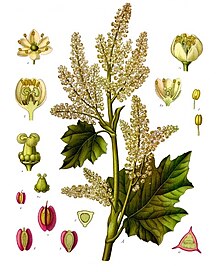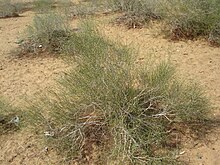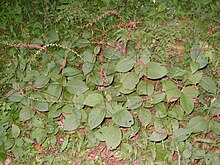Knotweed
| Knotweed | ||||||||||||
|---|---|---|---|---|---|---|---|---|---|---|---|---|

Alpine dock ( Rumex alpinus ) |
||||||||||||
| Systematics | ||||||||||||
|
||||||||||||
| Scientific name | ||||||||||||
| Polygonaceae | ||||||||||||
| Yuss. |
The knotweed plants (Polygonaceae) are a plant family in the order of the carnation-like (Caryophyllales) within the flowering plants (Magnoliopsida). The 48 or so genera with about 1200 species occur mainly in the northern temperate zones , with a few species in the tropics or permafrost areas .
description

Appearance and leaves
Often there are herbaceous plants , but there are also woody taxa : shrubs (for example coccoloba species), lianas or, less often, trees ( triplaris ). Some species (for example Calligonum ) are rod bushes in which the shoot axes take over the main part of photosynthesis . The independently upright, prostrate, winding or climbing shoot axes are striped, grooved or prickly and often have thickened nodes . More than three leaf tracks branch off at one node (multi-track, multilacunar).
The leaves are well developed or reduced. The mostly alternate, rarely opposite or whorled leaves are clearly or hardly recognizable with stalk or almost sessile. The leaf blades are usually simple. In the subfamily Polygonoideae are Stipules present and in the subfamily Eriogonoideae they are missing. The taxa of the subfamily Polygonoideae have a typical feature: the ochrea (tute), a tubular, mostly membranous sheath at the base of the petioles, which is formed by the overgrown stipules; it envelops the vegetation point and is broken through during the growth of the stem axis.
Inflorescences and flowers
Some species are monoecious ( monoecious ) or dioecious ( dioecious ) separately sexed. The terminal or pendant, ährigen , rispigen , traubigen or capitate inflorescences often contain many flowers. The petioles are sometimes articulated.
The rarely unisexual, mostly hermaphrodite flowers are relatively small, radial symmetry and threefold. There are one or two circles, each with three membranous bloom cladding leaves , which all or only the inner ones enlarge to the point of fruit formation and are also preserved on the fruit and can then be winged, warty or thorny. There are rarely one, usually two or three circles with three stamens each. The stamens are free or at most grown together at their base. The dust bags have two counters and open with longitudinal slots. The annular disc is often lobed. Two or three, rarely four carpels have become a top permanent, single-chamber ovary grown. The two or three, rarely four styles are completely free or only fused at their base.
Fruits and seeds
The mostly triangular, biconvex or biconcave nut fruits , also called achenes in this family , are often winged thanks to the durable bloom bracts. The seeds contain a lot of endosperm . The embryo is straight or curved, rarely folded.










Systematics and distribution
The species of the earlier Calligonaceae Khalk families . , Coccolobaceae FABarkley nom. nud., Eriogonaceae G.Don , Persicariaceae Martinov , Rumicaceae Martinov are included here today.
The knotweed family is divided into two subfamilies and contains around 43 genera (according to Brandbyge 1993 - as in the following list - there are more (around 53), since Polygonum is divided into several genera there). It contains 1110 to 1200 species.
Subfamily Polygonoideae
In China there are about 13 genera with about 238 species, 65 of them only there. About 16 genera with about 160 species occur in North America, mainly in temperate regions.
The subfamily Polygonoideae contains 15 to 28 genera with 590 to 850 species:
- Mountain knotweed ( Aconogonon (Meisn.) Rchb. , Syn .: Aconogonum Rchb. Orth. Var., Pleuropteropyrum H.Gross ): The approximately 25 species are common in Eurasia and three species are found in western North America.
- Buckwheat ( Atraphaxis L. , Syn .: Physopyrum Popov , Tragopyrum M.Bieb. ): The approximately 25 species come from North Africa and South Europe , Southwest Asia , Central Asia to the Himalayas and East Siberia .
-
Wiesenknöteriche ( Bistorta (L.) Adans. ): The approximately 50 species are distributed in arctic to temperate Eurasia and four species occur in western North America, including:
- Snake knotweed ( Bistorta officinalis Del. )
- Knollchen knotweed ( Bistorta vivipara (L.) Del. )
- Calligonum L. (Syn .: Pterococcus Pall. ): The 35 to 80 species occur in the Mediterranean and Asia. There are around 23 species in China, eight of them only there.
- Duma T.M. Schust. : The four or so species occur in Australia.
- Stechampfer ( Emex Neck. Ex Campd. ): The only two species are native to the Mediterranean and southern Africa, and neophytes in Australia and the New World .
- Eskemukerjea Malick & Sengupta : It contains only one or two species, but they are also included with Fagopyrum .
- Buckwheat ( Fagopyrum Mill. , Syn .: Harpagocarpus Hutch. & Dandy , Pteroxygonum Dammer & Diels ): The 15 or 16 to over 23 species are native to Eurasia and East Africa. There are about ten species in China, six of them only there.
- Winged knotweed ( Fallopia Adans. , Syn .: Bilderdykia Dumort. , Sometimes including Reynoutria Houtt. ): Depending on the scope of this genus, 12 to over 17 species are widespread in the northern hemisphere and in South America, especially in the northern temperate zone. Eight species occur in North America to Mexico. Well-known examples are the Japanese knotweed and fallopia baldschuanica .
-
Homalocladium (F.Muell.) LHBailey : It contains only one species (which is also assigned to Muehlenbeckia ):
- Homalocladium platycladum (F.Muell.) LHBailey : It is native to New Guinea and the Solomon Islands and occurs as a neophyte in Central and South America.
- Knorringia (Czukav.) Tzvelev : The two or so species are common in Asia.
-
Koenigia L .: The six or so species occur in the Arctic, circumpolar, in the northern European mountains, in eastern Asia and in northern North America and in southernmost South America; including:
- Alpine knotweed ( Koenigia alpina (All.) TMSchust. & Reveal , Syn .: Persicaria alpina (All.) H.Gross )
- Koenigia islandica L.
- Wire shrubs ( Muehlenbeckia Meisn. ): It contains (depending on the boundary) around 11 to 23 species that are common in Central and South America, Australia, New Guinea, Oceania and New Zealand. There are two types of neophytes in North America.
- Oxygonum Burch. ex Campd. : The approximately 22 species occur in Africa and Madagascar.
-
Sourling ( Oxyria Hill ): The one or two to four species occur circumcumpolar in arctic areas and in the mountains of Eurasia and western North America, including:
- Alpine sourling ( Oxyria digyna (L.) Hill )
- Oxyria sinensis Hemsl. : It thrives at altitudes from 1,600 to 3,800 meters in the Chinese provinces of Guizhou , Sichuan , Xizang and Yunnan .
-
Parapteropyrum A.J.Li : It contains only one species:
- Parapteropyrum tibeticum A.J.Li : It thrives in dry river beds and in thickets in valleys at altitudes of 3000 to 3400 meters only in the Tibet Autonomous Region .
- Persicaria ( Persicaria . (L.) Mill , Syn .: Amblygonum . (Meisn) Rchb. , Antenoron Raf . Chylocalyx Hassk ex Miq.. , Tovara Adans. ): It contains 100 to 150 species almost worldwide.
- Polygonella Michx. (Syn .: Delopyrum Small , Dentoceras Small , Gonopyrum Fisch. & CAMey. , Thysanella A. Gray ): The approximately eleven species occur only in eastern and south-central areas of the USA.
- Bird knotweed ( Polygonum L. ): The approximately 65 species are widespread in the temperate areas of the northern hemisphere and are neophytes in many areas of the world.
- Pteropyrum Jaub. & Spach : The six or so species occur in Southwest Asia .
- Winged knotweed ( Reynoutria Houtt. , Syn .: Pleuropterus Turcz .; Are often also associated with Fallopia ): It contains at least five species.
- Rhubarb ( Rheum L. ): The approximately 60 species are widespread in the temperate areas of Eurasia .
- Rubrivena M.Král (often referred to as Persicaria or Polygonum see left): It contains a maximum of two species.
- Dock ( Rumex L. , Syn .: Acetosa Mill. , Acetosella (Meisn.) Fourr. , Bucephalophora Pau ): The 190 to 200 species are distributed almost worldwide in the temperate areas.
Subfamily Eriogonoideae
It is predominantly New World and contains 20 to 28 genera with 325 to 520 species. Only two to four species are native to Africa. The center of the biodiversity are the temperate areas in western North America from Alaska to Mexico with very many species in California. Relatively few species are native to the eastern United States. In North America there are about 19 genera with about 281 species. In South America there are only a few species in Argentina and Chile. Most of the woody species are dioecious, separate sexes ( diocesan ).
-
Acanthoscyphus Small : It contains only one species:
- Acanthoscyphus parishii (Parry) Small : It occurs in four varieties in southern California .
- Afrobrunnichia Hutch. & Dalziel (also referred to as Brunnichia ): The only two to three species are common in Africa.
-
Antigonon Endl. (Syn .: Corculum Stuntz ): The six or so species are common in the Neotropic , including:
- Mexican knotweed ( Antigonon leptopus Hook. & Arn. )
-
Aristocapsa Reveal & Hardham : It contains only one species:
- Aristocapsa insignis (Curran) Reveal & Hardham : This endemic thrives at altitudes of 300 to 600 meters only in western central California.
-
Brunnichia Banks ex Gaertn. (Syn .: Rajania Walter ): It contains only one species (some authors also place the species of the African genus Afrobrunnichia here):
- Brunnichia ovata (Walter) Shinners : It thrives at altitudes of 0 to 200 meters only in the southeastern USA.
-
Centrostegia A. Gray ex Benth. : It contains only one type:
- Centrostegia thurberi A. Gray ex Benth. : It occurs in southwestern North America.
- Chorizanthe R.Br. ex Benth. (Syn .: Acanthogonum Torr. , Eriogonella Goodman ): The approximately 50 species are widespread in the New World, 33 of which are found in North America.
- Coccoloba P.Browne (Syn .: Campderia Benth. ): The approximately 120 species are widely used in the Neotropics.
-
Dedeckera Reveal & JTHowell : It contains only one type:
- Dedeckera eurekensis Reveal & JTHowell : It thrives at altitudes of 1200 to 2200 meters in California and is only known from small, isolated stocks.
-
Dodecahema Reveal & Hardham : It contains only one type:
- Dodecahema leptoceras (A.Gray) Reveal & Hardham : This endangered endemic thrives at altitudes of 200 to 700 meters in the lower range of the mountains around Los Angeles, California.
- Eriogonum Michx. : The approximately 250 species are common in North America and northern Mexico.
-
Gilmania Coville (Syn .: Phyllogonum Coville ): It contains only one species:
- Gilmania luteola (Coville) Coville : This endemic thrives on alkaline and saline soils at altitudes of 10 to 500 meters in California only in the Death Valley area.
-
Goodmania Reveal & Ertter (Syn .: Gymnogonum Parry nom. Inval.): It contains only one species:
- Goodmania luteola (C. Parry) Reveal & Ertter : It occurs in California and Nevada .
- Gymnopodium Rolfe ( Millspaughia B.L.Rob. ): The three species occur in Central America.
-
Harfordia Greene & C. Parry : It contains only one species:
- Harfordia macroptera (Benth.) Greene & C. Parry : It occurs only in Baja California ,Mexico.
-
Hollisteria S. Watson : It contains only one species:
- Hollisteria lanata S. Watson : It only thrives in California at altitudes of 10 to 1000 meters.
- Johanneshowellia Reveal : The only two species occur in the western United States. Johanneshowellia crateriorum is known only from the lunar crater area of Nye County.
- Lastarriaea J.Rémy : Of the only three species, one occurs only from California to the Mexican Baja California and the other two are native to Chile.
-
Leptogonum Benth. : It contains only one type:
- Leptogonum domingense Benth. : This endemic occurs only on Hispaniola .
- Mucronea Benth. : The only two species occur in California.
-
Nemacaulis Nutt. : It contains only one type:
- Nemacaulis denudata Nutt. : It occurs in two varieties from the southwestern USA to northwestern Mexico.
- Neomillspaughia S.F.Blake : The only two species occur in Central America .
- Oxytheca Nutt. (Syn .: Brisegnoa Remy ): The only three species occur in western North America and in the Andes of Chile and Argentina.
- Podopterus Bonpl. : The only three species occur in Mexico and Guatemala.
-
Pterostegia fish. & CAMey. : It contains only one type:
- Pterostegia drymarioides fish. & CAMey. : It occurs from the western USA to the Mexican Baja California.
- Ruprechtia C.A.Mey. (Syn .: Enneatypus Herzog ): The 16 or so species are widespread in the Neotropic.
- Sidotheca Reveal : The only three species occur from California to northwestern Mexico.
- Stenogonum Nutt. : The two types are found in the western United States.
-
Symmeria Benth. : It contains only one type:
- Symmeria paniculata Benth. : It occurs in northern South America and West Africa.
-
Systenotheca Reveal & Hardham : It contains only one type:
- Systenotheca vortriedei (Brandegee) Reveal & Hardham : It occurs in California.
- Triplaris Loefl. ex L. (Syn .: Blochmannia Rchb. , Vellasquezia Bertol. ): The approximately 17 species are widespread in the Neotropic.

use
The buckwheat was once an important part of the diet and is still used today in the kitchen. Varieties of Rheum rhabarbarum are grown as fruit . As medicinal plants are Rheum rhabarbarum and Rheum officinale used.
swell
- The Polygonaceae family on the AP website . (Sections Description and Systematics)
- The Polygonaceae family at DELTA by L. Watson & MJ Dallwitz. (Section description)
- Craig C. Freeman, James L. Reveal: Polygonaceae - the same text online as the printed work , In: Flora of North America Editorial Committee (Ed.): Flora of North America North of Mexico , Volume 5 - Magnoliophyta: Caryophyllidae, part 2 , Oxford University Press, New York and Oxford, 2005, ISBN 0-19-522211-3 . (Sections Description and Systematics)
- Anjen Li, Bojian Bao, Alisa E. Grabovskaya-Borodina, Suk-pyo Hong, John McNeill, Sergei L. Mosyakin, Hideaki Ohba, Chong-wook Park: Polygonaceae , pp. 277–337 - online with the same text as the printed work , In: Wu Zheng-yi, Peter H. Raven (Eds.): Flora of China , Volume 15 - Myrsinaceae through Loganiaceae , Science Press and Missouri Botanical Garden Press, Beijing and St. Louis, 1996, ISBN 0-915279-37-1 . (Sections Description and Systematics)
- Description of the family from the University of Ulm. (German)
- AS Lamb Frye, KA Kron: rbcL phylogeny and character evolution in Polygonaceae. In: Systematic Botany , Volume 28, Issue 2, 2003, pp. 326-332: doi : 10.1043 / 0363-6445-28.2.326 (currently unavailable) JSTOR 3094001
Individual evidence
- ↑ a b c d e f g h i j k l m n Anjen Li, Bojian Bao, Alisa E. Grabovskaya-Borodina, Suk-pyo Hong, John McNeill, Sergei L. Mosyakin, Hideaki Ohba, Chong-wook Park: Polygonaceae , Pp. 277–337 - the same text online as the printed work , In: Wu Zheng-yi, Peter H. Raven (Ed.): Flora of China , Volume 15 - Myrsinaceae through Loganiaceae , Science Press and Missouri Botanical Garden Press, Beijing and St. Louis, 1996, ISBN 0-915279-37-1 .
- ↑ a b The family of the Polygonaceae at DELTA by L. Watson & MJ Dallwitz.
- ^ A b Polygonaceae in the Germplasm Resources Information Network (GRIN), USDA , ARS , National Genetic Resources Program. National Germplasm Resources Laboratory, Beltsville, Maryland. Retrieved December 9, 2013.
- ↑ a b c d e f g h i j k l m n o p q r s t u v w x y z aa ab Craig C. Freeman, James L. Reveal: Polygonaceae - online with the same text as the printed work , In: Flora of North America Editorial Committee (Ed.): Flora of North America North of Mexico , Volume 5 - Magnoliophyta: Caryophyllidae, part 2 , Oxford University Press, New York and Oxford, 2005, ISBN 0-19-522211-3 .
- ^ David John Mabberley: Mabberley's Plant-Book. A portable dictionary of plants, their classification and uses. 3rd edition, Cambridge University Press 2008, ISBN 978-0-521-82071-4 .
further reading
- TM Schuster, JL Reveal, MJ Bayly, KA Kron: An updated molecular phylogeny of Polygonoideae (Polygonaceae): Relationships of Oxygonum, Pteroxygonum, and Rumex, and a new circumscription of Koenigia. In: Taxon , Volume 64, Issue 6, 2015, pp. 1188–1208. doi : 10.12705 / 646.5 full text PDF at ResearchGate . ISSN 0040-0262

